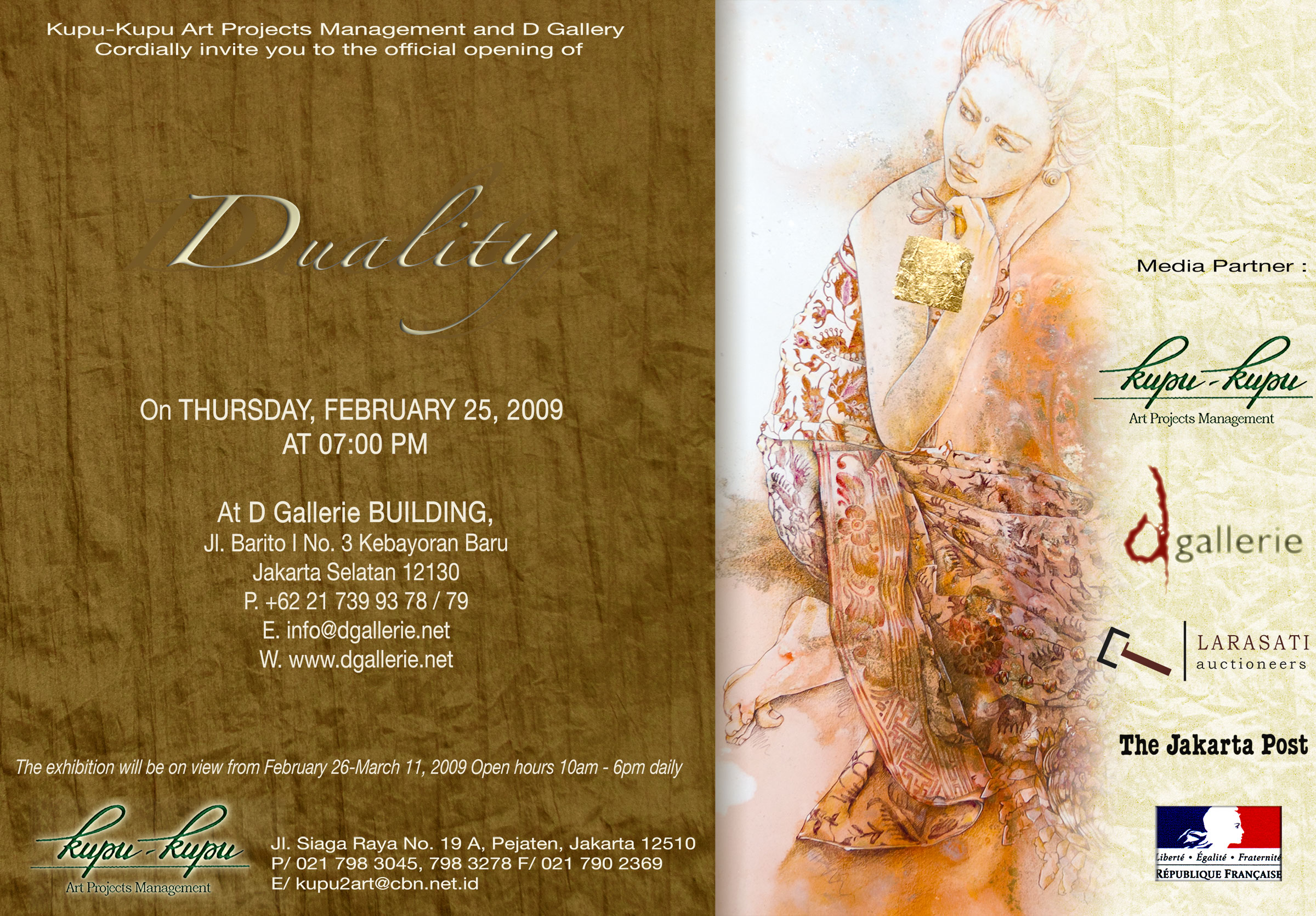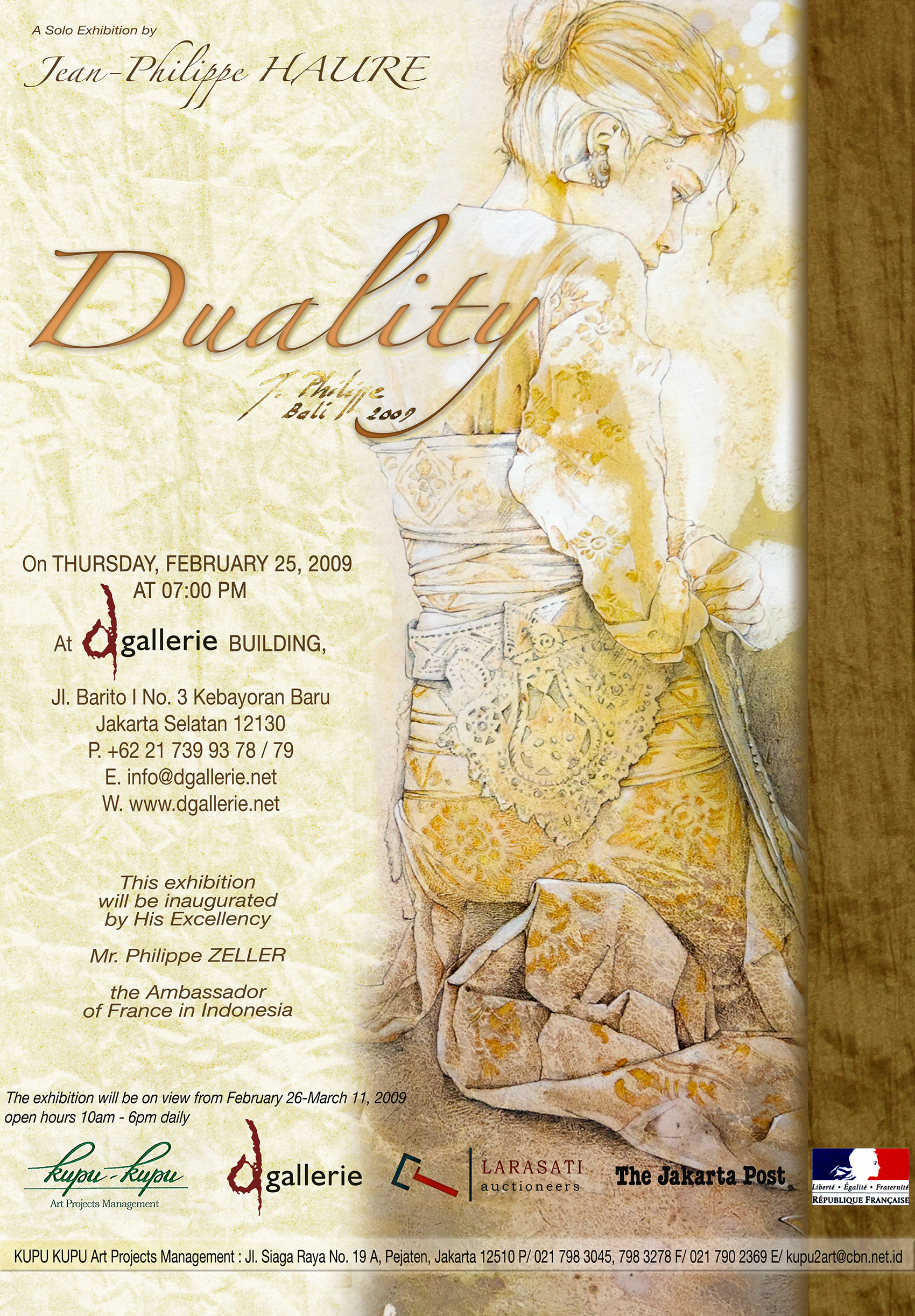J-PHILIPPE tries to go beyond all differences in a single message of hope.
Duality of the real ... and beyond By Jean Couteau [1]

What does one see first? Sometimes it is a sort of “haze”, which draws you into an unreal world, a world of the unsaid and the unknown where dreams and emotions are at the forefront. Only then do the lines defining the human characters emerge – little by little, as your eyes relegate the “haze” to an abstract function – to take on the hard appearance of Balinese social reality. But sometimes the opposite happens. It is the lines that first attract attention, but just as you are entering the scenes of Balinese life so depicted, your eye has already jumped into the unreal space of the “haze” and the reality of dreams and emotions.
The works of the young French painter, J-PHILIPPE – exhibited at D Gallery between 27th February and 11th March 2009 , are indeed an invitation to look differently at reality.
Social reality, in the history of figuration, is traditionally represented either by emphasizing the scene, as in French mid-19th realism, or by modifying the rules of the representation of form, as in classical Expressionism. Jean Philippe’s approach is different. He sticks to the real – his figures are derived from photography, his photographs are of very high quality – but he modifies this real in two different ways: by keeping important elements of the original image empty, and thus letting us imagine some unrepresented parts of the real scene; and, more importantly, by creating the aforementioned “haze” atmosphere looming over the scene, to suggest that “reality” is not “reality” or, rather, that there are several possible readings of any reality. By hovering between the two poles of “haze” and “reality”, J-PHILIPPE seems to be telling us that perception is not something fixed and that artistic expression mustn’t be either.
It is also possible to make a social reading of J-PHILIPPE’s works and see them as a visual discourse on the condition of Balinese women. These women, he seems to tell us, have two faces. Some of them are dressed in the most beautiful dance costumes. They are pretty, of a still innocent beauty. Often staring away fixedly, they appear lost in some private thought, in some need to have dreams and keep secrets. Others have the gait and clothing of women workers. Old and wrinkled, they have no time for broken dreams or secrets. Beauty and the feminine are dead in them, taken away by a life of toil and labor. Those two types of women are the dual face of Balinese womanhood.
Remarkable, in this social reading, is the absence of any exotic stereotyping of the sort that has long been the staple of Western artists depicting Bali. J-PHILIPPE’s “Balinese women”, however beautiful they may be, are bereft of any sexual allusions. They visually stand out on account of what appears to be their virginal innocence. They are not featured as prey. The painter’s gaze is not predatorial. He simply portrays the beauty in those women, not some sort of exotic difference that would make them the objects of sexual fantasy. An attitude much healthier than that of most of his Western artist predecessors. To him, the beauty of Balinese women should not prevent one from seeing them merely as humans to empathize with.
Free of Western sexual stereotypes in his treatment of Balinese women’s beauty, J-PHILIPPE is also free of normative cultural stereotyping. When he depicts the other type of Balinese women, the old, ugly, and burdened ones, he does not try to put himself on a “moral” high ground and say that it is improper to have women work and carry burdens the way Balinese women usually do. To him, their ugliness should not prevent one from seeing even old Balinese women merely as humans to empathize with.
In short, what characterizes J-PHILIPPE’s attitude in his treatment, in his works, of the social issue of Balinese womanhood, is his total absence of prejudices – colonial as well as post-colonial. He seems to tell us that Balinese women may be beautiful, but this should not entitle Westerners to “see” and treat them as sexual objects in the name of an “exotic” difference enshrined in colonial history. Similarly, Balinese elderly women may be over-burdened by the work they are compelled to do by their tradition, but this should not entitle anyone to position himself as a lesson-giver in the name of some abstract ideal of civilized behavior. Societies, his works show us, are made up of “real” people whose behavior and value system ought to be respected for their own sakes. Empathy, or “Love” (in the Christian translation of empathy), is the only way these issues should be approached.
There is indeed something “Christian” that inhabits J-PHILIPPE. Not Christian as a mere general cultural reference, but as a behavioral inspiration for daily life. It should be noted here that the artist first came to Indonesia in 1991 not simply to work, as a graduate of the famous Ecole Boulle of arts and crafts in Paris, but as a faithful young Catholic lay brother, entrusted with the running of an art school owned by the Catholic church in Gianyar. So, unlike others, he came to “serve”, not to look for adventure or make a fortune. Now settled in Gianyar, he sees in the Balinese and other Indonesians living around him, not simply “Balinese” or “Indonesians”, but human brothers with whom he shares a simple daily, and very religious life.
In this context, the “haze” comes back into the picture with a new layer of meaning. J-PHILIPPE always begins his works by first painting the abstract beige or brown color that I have called the “haze”, thus creating an atmosphere that dampens realism to take us somewhere beyond it. This “haze” can be construed to represent the “unknowable” that remains the realm of each of us in our irreducible “separateness”. It may also be the dreams of dancers or the suffering of old ladies. But at a deeper level, it evokes the “beyond” that links separateness, dreams and pain, and eventually all of us, in the same Unknown that calls for meditation and prayer.
So, when looking at J-PHILIPPE’s paintings, let’s go first, as he does, into what he “sees” and visually depicts, and then, move into what he “feels” and even what he believes, into his beautiful haze, where he tries to go beyond all differences in a single message of hope.

Please note
[1] French sociologist, an eminent art critic, specialist in the painting of Ubud, installed for twenty years in Bali.
